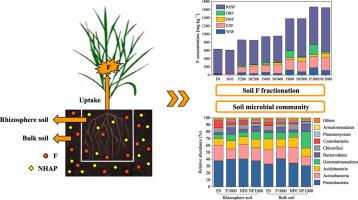Journal of Hazardous Materials ( IF 13.6 ) Pub Date : 2020-11-27 , DOI: 10.1016/j.jhazmat.2020.124694 Chun-dan Gan , Yan-bo Jia , Jin-yan Yang

|
Nano-hydroxyapatite (NHAP), possessing high defluoridation capacity, has been widely used to remove fluoride (F) from polluted water, but little is known about how it affects the bioavailability and toxicity of soil F towards plants. Here, the impact of NHAP (2% w/w) amendment on immobilization, speciation and accumulation of F was studied in a soil-plant system. The results revealed that the NHAP amendment worked effectively to reduce levels of water-soluble F (37.3%−87.8%) and increase available P (76.6%–147%). X-ray photoelectron spectroscopy analysis indicated that the formation of insoluble CaF2 and the ion exchange of F− with OH− into NHAP might be involved in the mechanism of F immobilization and soil pH elevation. Exposure to NHAP significantly decreased the abundance of Cyanobacteria in tested soils, and Gemmatimonadetes abundance in bulk soil was significantly higher than that in rhizosphere soil at 1,000 mg kg−1 F spiked level. Additionally, NHAP amendment decreased F accumulation in wheat shoots (9.10%–18.7%) and roots (3.88%–22.4%), which could mainly be attributed to the reduction of soil bioavailable F and the supplement of Ca from NHAP. These results suggest that NHAP could be a promising amendment to be applied to acidic soil contaminated with F.
中文翻译:

纳米羟基磷灰石改良剂修复氟化物污染的土壤:土壤氟化物生物利用度和微生物群落的响应
具有高脱氟能力的纳米羟基磷灰石(NHAP)已被广泛用于从污水中去除氟化物(F),但对其如何影响土壤F对植物的生物利用度和毒性知之甚少。在此,在土壤-植物系统中研究了NHAP(2%w / w)修正对F的固定化,形态形成和积累的影响。结果表明,NHAP修正有效地降低了水溶性F(37.3%-87.8%)的水平并增加了有效P(76.6%-147%)。X射线光电子能谱分析表明,不溶性的CaF的形成2和F的离子交换-用OH -进入NHAP可能与F固定化和土壤pH升高有关。暴露于纳米羟基磷灰石显著下降的丰度蓝藻中测试土壤和芽单胞菌门丰度在土体较显著更高根际以1000毫克千克-1 ˚F掺入水平。此外,NHAP修正降低了小麦芽(9.10%-18.7%)和根系(3.88%-22.4%)中的F积累,这主要归因于土壤生物有效性F的减少和NHAP中钙的补充。这些结果表明,NHAP可能是一个有前途的修正案,可应用于被F污染的酸性土壤。



























 京公网安备 11010802027423号
京公网安备 11010802027423号